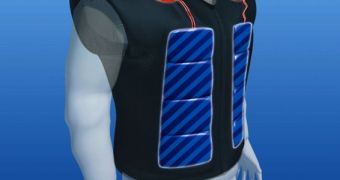It is said that the fashion industry always looks towards the future when designing clothing; however they hardly need the help of stiff scientists when it comes to developing them. Now they can finally incorporate some new accessories and clothes, such as garments that convert the extra energy produced by our bodies, while walking for example, into efficient electric energy that could power your MP3 player, with the help of exoskeletons that enhance your muscle strength at the same time.
For example, the devices incorporated into your clothes could be used to recharge electronics, only by plugging them in, as CSIRO scientists from Australia are currently designing clothes that can convert simple vibration produced by a walking person into electric energy. The energy produced by these converters will be stored in flexible batteries, also incorporated on the clothes to store the energy until it is needed.
According to Adam Best, the principal research scientist with CSIRO's energy technology division, these garments would look just like any other, but would have the extraordinary capability of converting vibration to electricity. In October this year, the CSIRO board decided that a fund of four million dollars will be specially allocated for research in this domain.
The primary objective of these kinds of devices was to develop this technology for military application, so that soldiers present in different combat areas would not need to carry heavy batteries, instead they could wear them. However, this device could have a bigger success in civilian applications, which could use them to power different electronic devices, without worrying about the fact that the battery will fail.
Similar ideas to convert energy efficiently involves the use of certain flexible materials to create solar cells that would be used to make solar powered handbags or clothing. Applications in the clothing materials could create uniforms that would not need cleaning or washing for weeks, as the U.S. Air Force claim that they have created a material by attaching particles a nanometer wide on multiple types of fibers by using microwave radiation, which will be able to repel most of the liquid substances and bacteria.
Research in the advanced material resulted in creating carbon nanofiber yarns to make uniforms even stronger than Kevlar that would act as bulletproof vests or turn relatively soft helmets too hard, in the event of a crash.
However, the fabrics industry does not necessarily need to use high tech material to create clothing. Remnant organic material such as feathers or rice straws, could be one day used to produce yarns similar to wool or even cotton, to prevent the use of pollutant materials such as polyester, derived from petroleum.
Amongst other goals, the scientific community hopes to be able to create strands of wool that do not shrink or itch through a technique which involves the partial degradation of the fibers, to smooth them out.
CSIRO represents national government body of scientific research based in Australia. It was originally founded in 1926, under the name of Advisory Council of Science and Industry and mainly focused its research on primary and secondary industries, providing multiple inventions and breakthroughs amongst which the Atomic Absorption Spectroscopy, the Microwave Landing System or the famous Wireless LAN technology.

 14 DAY TRIAL //
14 DAY TRIAL //